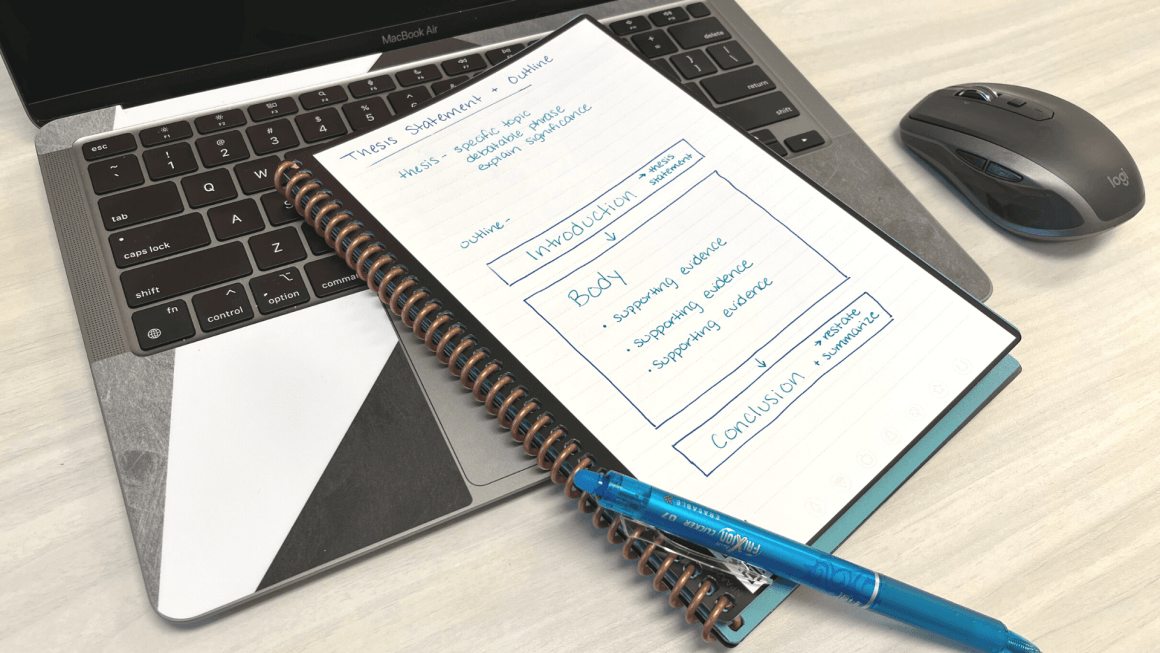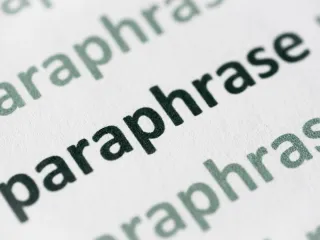How to Write a Thesis Statement & Essay Outline
Writing your thesis statement and planning out your essay outline are two of the most important things you can do if you want to have a concise, accurate, and interesting argumentative essay. In addition, the time you spend brainstorming your research paper will save you hours of edits in the long run.
A good thesis statement is the backbone of your entire essay. Fortunately, writing thesis statements is easy if you follow our step-by-step guide that walks you through crafting a robust argumentative thesis statement.
The main point of your essay should be highlighted in your thesis statement. You can further expound upon this central theme in your introductory paragraph, letting your audience know exactly what they can expect from your paper. It’s essential to make your thesis statement as straightforward as possible, laying out the case for the rest of your paper.
What is a Thesis Statement?
A strong thesis statement gives your audience a clear understanding of what to expect from your essay. Think of it like a micro-roadmap that efficiently lets your readers know where the essay will take them.
Most thesis statements revolve around proving a point or making a specific claim. While it can be based upon your opinion, it’s also vital to remember that you need to substantiate any claims that you make with facts.
It’s important to have one significant theme in your thesis statement. If you try to express too many things, you will confuse the reader. Thesis statements need to be concise, crystal-clear and express a statement of fact. Therefore, mastering a thesis is a crucial part of all essay writing.
You can also use your thesis statement to address a specific issue and explain how you’ll break it down in your essay. If you’re talking about something controversial, you should substantiate your claims with facts and logic. The best essays tackle complex topics by breaking them down into logical and easily understandable chunks.
If you’re dealing with a hot-button topic, it’s a good idea to mention that there are other viewpoints. Then, you can dissect these viewpoints and explain why you disagree with them later on in your essay.
What to Include in a Thesis Statement
Start off with a working thesis. Give some thought to your thesis statement’s significant points, and condense them until you have a very compact but straightforward statement about the issue. Make sure that you include plenty of supporting evidence to back up your thesis.
Although all thesis statements are different, there are some general qualities that you should strive to include. First, spend some time crafting your thesis because the clearer you are on your objectives, the easier your essay will be to write.
- Your thesis statement should be concise, direct, and clear
- It should encapsulate your essay as much as possible
- The thesis should contain a combination of opinion and support
You also need to brainstorm the critical components of your essay. What are you trying to achieve? Who is your audience? Think about what the reader would want to learn from the essay and distill it down into one very powerful line.
It’s completely natural to spend a significant amount of time on your thesis statement. You might be tempted to jump right into your essay without ironing out the finer points, but this can make the writing muddied or challenging to read. So instead, spend as much time as you need to come up with a good thesis statement that you can back up with facts.
What is an Outline?
Once you have your thesis statement, it’s time to jump into your outline. Good outlines combine logical frameworks with plenty of brainstorming and act as a template for the whole essay. Your outline is an integral part of the writing process, as it allows you to look at all of the subtopics of your essay in logical order.
Every subtopic should reflect your thesis statement and bolster your position. Start with your introductory paragraph and then drill down into the finer points of the essay. Finally, address conflicting viewpoints and explain why you’ve taken the position you have.
A constructive way of coming up with opposing viewpoints is to write down bullet points from the other side. Then, think of all of the counterarguments that you’ve heard and write down logical rebuttals to them. If you’re having trouble coming up with counterarguments, search for your topic online and read a few papers that express differing views.
The best outlines are analytical, expository, and argumentative. They teach the audience something new through a logical process. Although your thesis statement can be based on opinion, it’s vital that you back it up with facts and explain why the audience should trust your authority.
Drafting Your Essay Outline
Now, it’s time to draft your essay outline. The more prep work you do in the beginning, the fewer edits that you’ll need to do later on. Identify what will go into your first paragraph and what the key points of your essay will be.
Write down these points and organize them into a logical framework. Try to blend the points into each other, guiding the reader on a comprehensive overview of why your thesis statement is important and correct. Every subtopic should echo your thesis statement.
All outlines should contain an introduction, body, and conclusion.
Introduction
Your introduction is a brief overview of your essay. Give your reader a general idea of what you’ll be covering and why it’s crucial. You don’t have to go into too much detail here, as your essay body will undoubtedly elaborate on your key points.
Body
Your body will be the longest part of the essay and contain all of your subtopics. Please spend some time crafting and organizing your body so that it’s as straightforward as possible with a strong focus on accessibility. Remember, each body paragraph should bring something new to the essay.
Conclusion
The conclusion is where you wrap everything up. Make sure that you restate your thesis and hit on any critical points the essay addressed. You will want to write a powerful closing statement too.
Final Thoughts
Once you have your thesis statement and outline done, it’s time to start writing your essay. At this point, you should think about what style you want to use. Some high schools and colleges prefer APA style, whereas others want you to write your essay in AP style. If you don’t know which one your school is looking for, ask your professor or inquire at your writing center. There are guides for both online.
After you’re done writing your essay, read it through to ensure that it coincides with your thesis statement. If you’ve written your thesis statement and outline properly, there should be minimal content edits.









